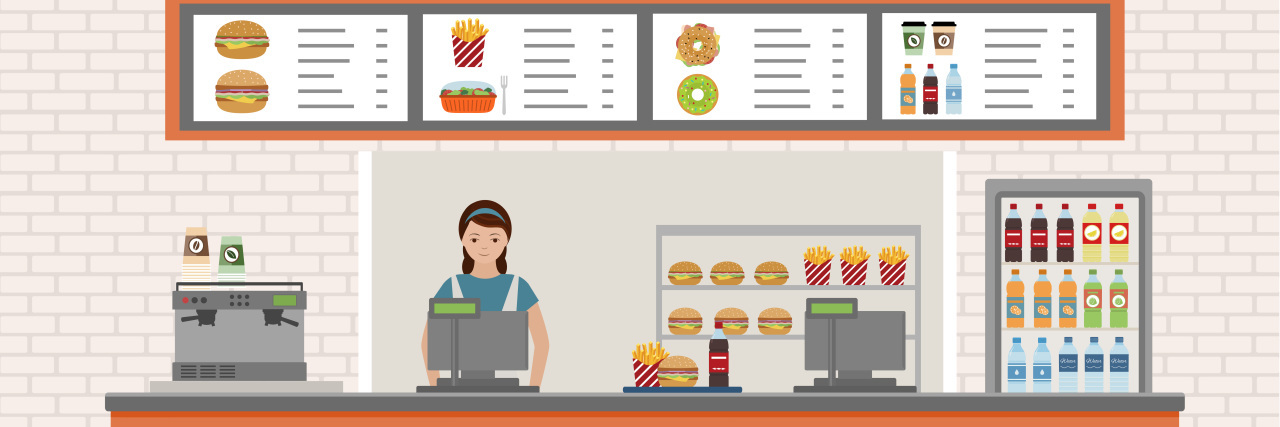I dread fast food restaurants. It’s not the mega calorie content of the portions or the artery clogging content of their offerings. It’s not even the hyper sodium and sugar counts on their nutritional explainers. It’s the ubiquitous menus behind the ordering stations that customers are meant to casually peruse while waiting to place their orders. It really doesn’t matter the lighting scheme, the font or the colors. Nine times out of 10, they are a blur to me.
Having this barricade is galling and humiliating. More than anything else, I do not want to stand out. Friends or relatives that know my situation will often offer to read menus to me but I am uncomfortable asking strangers for help because it requires an explanation as to why, a story I am tired of telling.
I was born with a visual impairment called optic atrophy — an underdeveloped optic nerve that manifests in severe myopia or nearsightedness which is correctable, but only to a point. Beyond a certain lens strength the effects reverse and my vision worsens. The best I’ve been corrected to is 20/80, so at 20 feet I can see what a baseline viewer can see at 80 feet. Put another way, I would need to be four times closer to that sign over the register to read it comfortably, most likely requiring me to be standing behind the person taking my order.
Sit down restaurants do not come with this same level of discomfort. Even if the printed menu uses small print, I have adaptive devices that help. I carry a pair of reading glasses, I have a credit card sized magnifying glass in my wallet, an assortment of magnifiers in my backpack, and as a last resort the camera on my smartphone can both brighten and magnify tiny text.
This problem isn’t restricted to dining out. For much of my life, reading street signs on a moving city bus afforded me an additional level of stress. Until I was familiar with other landmarks, I would ask the driver to tell me when we reached a particular place, and more often than not, she would forget. The good news is that technology has alleviated this problem on many routes as buses often have both an audible announcement of the next stop and a large enough display at the front of the bus. For many years, I would take a train when I could because the signs were larger at subway and railroad stations.
I’ve had to develop strategies throughout my life to maintain my independence and dignity. I was under the care of an ophthalmologist during my school years who was adamant that I remain in regular classrooms despite the urgings of school officials to put me in “special” classes. He told me and my parents that it would be uncomfortable but worth the discomfort to figure out how to navigate in a world of people whose visual acuity was far better than mine and had little comprehension of my “problem.”
I remember the first day of third grade explaining my visual limitations to my teacher and negotiating a way we could work around them. It was a big day for me. My parents had previously run interference but on that day it was my turn to initiate the conversation. We rehearsed the exchange several times, with my 8-year-old self crying over the burden being placed on my small shoulders. Our strategies generally involved a seat in the front row center and permission to get up to view other parts of the blackboard. How I managed to do this and not get singled out by my classmates as a freak is a wonder to me even today but I did it year after year.
Fast food restaurants continue to provide a unique challenge. The 8-year-old buried inside of me still wants to overcome this. I toy with the idea of carrying opera glasses or developing a phone app to meet the challenge. My mother used to soothe me by telling me that doctors would come up with a way to repair this when I was older and the grown up me still wants to believe her.
Restaurants are required by the American With Disabilities Act to provide accessible seating, bathrooms and door signage, but these regulations do not apply to menus. It may simply be too difficult to develop a standard that would apply to the spectrum of visual impairments, or maybe they have gotten an undeserved pass.
There are exceptions. I recently visited a Noodles and Company while traveling and was delighted to find the menu in huge letters on the wall as I entered. I could have pressed my face against it if necessary. I had no trouble ordering there.
I find myself grateful, though. The unfriendly environment forces me to seek out less mass produced dining choices, and to pack my own lunch more often than not. This tyranny of signs has limited my spontaneity, but maybe the trade off of better coping strategies and superior nutrition is worth it.

